Having wrapped my share of thread over the years, I thought it was time to revisit a long held interest of mine - traditional salmon flies. My first attempt years ago was pretty disappointing, and I was hoping my skills had evolved enough for me to take that next step and produce a better result.
In January 1999, I tried to tie a traditional salmon fly - a Fiery Brown to be exact. I remember feeling pretty good about that fly up to the point where it was time to add that first wing ingredient, and then the train came off the rails. There was an abrupt drop-off at the end of the dubbed
body, so of course the wing resisted laying down low. Not only that, but every time I tried to tie in the married slips of feathers, the top half - the mottled feathers - kept coming unmarried and the thread would slip
off. I never finished that one - just whipped a finish and set it aside. I was not up to the challenge at that time. I still have it somewhere, I think.
I remember exchanging emails with Bryant Freeman about that attempt. Bryants salmon flies were my inspiration as they are supremely beautiful, but yet are sleek, sparse, and entirely fishable. I've always been drawn
to flies like his, Bill Hunter's, and Poul Jorgensen's, because you can see they were tied by tyers who have fished the flies. The idea is not to have the tiniest head, or to show off the baby smooth floss body. The
idea is to tie a fly that is well proportioned to the hook, will hold up to casting, and will "swim" well in the water. Much like I always wanted my salmon hairwings to look like Warren Duncan's, I always
wanted to be able to tie traditional salmon flies like Bryant. He coached me as best as he could via text emails, but I knew I wasn't ready.
So here we are, almost nine years later, and I'm trying attempt number two. It certainly is an improvement over the previous attempt. I mean - heck - I finished it. But it still falls well short of the goal.
Tying flies is a learning process, a series of trials and errors, plenty of errors if you are like me. We learn from our mistakes, and I thought maybe someone reading this who is interested in salmon flies might learn
from mine. Lord knows I don't have many solutions to the problems I encountered, but maybe someone reading who is trying their first fly will have a few extra things to keep in mind when they start. There might also be someone
reading who wants to chime in with some advice for my next attempt - hopefully not another nine years in the future.
So with that, here goes the critique.

The Good
- I'm pretty pleased with everything from the butt backwards. That's not really a surprise, since I've tied tips and tags and crest tails many times in the past on hairwings and spey flies and what
not. Those components were not new to me. - I was pleased that I was able to get the underwing and the outerwing to hug the top of the body and not crook up like an open pocket knife. Once I got those tippet strands to lie low, I was actually optimistic
the fly would turn out ok. - The overall shape of the fly is ok, in spite of the empty space between the tip of the wing and the topping. The topping makes the fly look more top heavy than it really is because of that empty air. I think
it would fish well. - The throat is ok. Not great, but I don't think it is bad enough to go into the bad category. At least compared to the other bad stuff, lol.
The Bad
- Totally forgot the head on the Black Doctor is not a simply black thread head. Duh. No excuse for that. I was working from Poul's book with the black-and-white photos, but still. Even a black and white photo has a black head that looks black. It didn't
in the book, and that should have been a clue. - The side wing components - the married slips of teal and barred woodduck - seem a bit short. Jorgensen had them ending with the ends above the butt of the fly, but if I look at some other flies, like Bill Hunter's
in Judith Dunham's book, they extend a bit futher along the wing. Mine also are not aligned very well with the other wing components. My teal sides are a little dark, too, not a vivid black and white. I might paw
through my stuff to see if I can find a better pair. These could be gadwall, as the bag was not labelled. I know I have better feathers somewhere. - The head, while not too bulky, is far too long, which of course is because I ended the body too early on the hook.
- The topping should have hugged the top of the wing a little better. I didn't take too much time to shape it properly, so I just took what the feather had to offer. It wasn't the straightest feather in the world,
either, so it's not nearly a good topping for the fly. Not shaping the crest also yielded that big old ugly blank space between the wing and the topping. - The wing tip extended outside the tail, which certainly wasn't the plan. The plan was for the upper tip of the wing to just touch the tip of the tail, like in Poul's fly. This is borderline ugly.
- My florican sub is not good. It doesn't have good color, is a real bear to marry to other feathers, and is short. If I'm going to do this again, I need an upgrade. Or I could just leave that part out while
I'm learning to tie these things. No sense wasting good feathers on bad flies.
The Ugly
- Whatever passes for a bronze mallard roof on the fly is super ugly. What a mess. I tried for a good half hour to get a real roof over the fly and finally just waved my hands and gave up.
I then tried to tie a thin slip of bronze mallard along the top edge of the fly, and you can see how well that took. Thus another episode in a long running troubled relationship with bronze mallard in my
tying career. I can count on one hand (one finger maybe) how many times I've reached in my baggy of bronze mallard and came away with a satisfactory fly. - The body hackle is a too long, and it is not tapered at all. I might have to try a different hackle next time. To me, the hackle as much as the bronze roof makes the fly look sloppy and - well - ugly.
- You can see some of the working thread behind the head, where I tied off the body hackle. Man, that just sticks out in my eye like a sore thumb. Argh! I ended the body way to far back from the eye.
What I learned
- I took the time to plan ahead the shape of the tail, which is the most important ingredient of the fly because everything else has to be tied to fit the tail. A bad tail, and you're dead.
So I took the time to draw out a hook on a piece of paper and draw in the shape of the tail I wanted to help me select and tie in a crest tailing. However, I did not take that time to plan out the body the
same way. When you have that many materials to tie into one area, you have to plan ahead, and I gave myself a bit too much room. Next time, I'd widen the tinsel wraps just a bit, so the last wrap is a
little closer to the eye. Of course, these steps would be automatic to someone who has tied these flies for awhile, but for the beginner it helps to plan these steps out in advance since so much depends
on proper placement of these foundation materials. - The second early mistake I made was not paying better attention to the hackle I chose. I just picked up a new claret neck at the IFTS and was hot to use it. That neck might not be the right choice for this
fly. I have an old chinese neck I might try next time, to see if I can get more taper to the hackle. The Whiting neck will be better for streamer wings (which is exactly what I got it for). - If I am going to do many more of these flies, I need to sit down and spend a couple afternoons fiddling with bronze mallard. I cannot blame it on my materials - I have good bronze mallard. It's my technique.
I need to watch some experts handle it, and see if I can mimic that myself. That is one material I have not come close to mastering. - You can retie these salmon flies many times. I bet I tied those wing slips on a dozen different times and they were none the worse for wear (although maybe they are and I just don't see it). I retied the underwing,
throat, and wing several times trying to get things to sit right. I envy guys like Bryant who just grab the feathers, hold them to the hook, and they just magically affix themselves in perfect position. But even
if they don't go on properly the first time, just unwrap and try again. The wings are surprisingly durable and able to withstand more handling and re-attaching than I thought. - Looking at the fly again - I actually like where the wing is positioned. If I were to do it again, I think I'd make the tail a little flatter and not cocked up quite as high, which would lead to that long sleek
look I am after. The inner wing components tend to get hidden in that style of tying, but that's ok. I'd rather have a fishable fly where some parts are harder to see than a fly where you can see everything
but it would flap and fly apart with a single back cast. I feel the same about my Rangeley streamers. That beautiful floss body should be hidden underneath the hackle.
Oh well. Whattyagonnado? This attempt came out much better than the Fiery Brown way back when. I got off to a good start with the tail assembly, but the fly was doomed when I wrapped the ribbing too short. I think this
would be a fishable fly - and I might just do that if I ever make it up to the Salmon River during a run again - but it will not win any beauty contests.
Tying a salmon fly is humbling.
So - any experts out there who want to chime in with a few words of wisdom - feel free.
- Log in to post comments

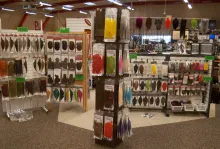
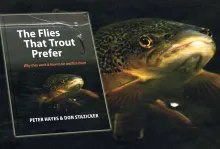
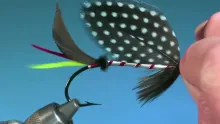
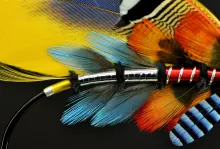
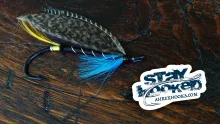
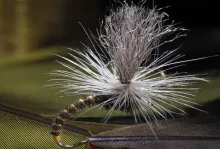

A very fishable fly
Hi Bob,
From what I can see from the picture, you have tied a very fishable fly. Some people tie flies just to impress us. They, however, don't usually fish. Some people tie the classics with equal care, but they tie their flies for fishing. And some people love to fish for Salmon and if they can't be on a river (Rivers freeze in Winter) they tie salmon flies to use when they can. (Or, just for the satisfaction of tying? Well, maybe both).
I had the very good fortune to live in Epping, NH in the late 70s and early 80s and spent many hours and lots of money at Bill's shop in New Boston. I studied with Bill whenever he offered a class and with Warren Duncan anytime he came down to teach us lowly mortals.
I then spent the next few years building the necessary assortment of materials to tie the classics correctly. And I tied 4 or 500 full dress feather wing Atlantic Salmon Flies on double hooks over the next 5 years. All of the flies that I tied were tied to fish.
I had the incredible luck to fish with Richard Adams on the Matapedia for three days one year and I think I might have seen a tear in his eye when he first saw my flies. "I haven' t seen some of those flies for many years, Boy. And I didn't expect to ever see them again. Do you want to do some real fishing?". Those kind words from the Dean of Salmon Guides made my day, my week, my year, hell, maybe my life as a Salmon Fisher.
By the way, it does get easier after the first 300 or so. Oh, by the way, I have three flies tied by Bill for sale on EBay. He tied them for my sample book many years ago and, well my eyes are not what they once were and besides, sadly I need the money.
Tight Lines and Fair Weather, my friend, and maybe in another lifetime we will meet on a river somewhere.
Richard Travers
Your flies are beautiful
bob your flies are beautiful i just wish i had half the talent that you have. I am not ready to salmon flies yet have only been tying one year and i am getting the hang of nymphs, drys.emergers and streamers ,deer hair poppers and someday going to try full dress salmon. so keep up the hard work and dont be so hard on yourself
Robin
The most important thing
bob,to me the most important thing that was not mentioned,and probably the one that is always forgoten, is your creativity,unique to every individual,copying a fly or tecnique is easy almost borring after awhile,the beaty of your fly,is your experiance,and as time goes by,and you are willing to experiment with different materials,the marriage of color and flow will come with trial and error,remember there are no rules to creativity,none, to have rules limits your fly and your creativity,the secret, take it to the next generation of tyers,or be imprisoned by the past,the flys of the future are waiting?, Phillip Catania
Tying classics is difficult
tying classics is difficult but practice makes perfect i think your body length was not too bad look at a step by step sequence by a master and you will realise that a lot of tying these things is about concealment of ugly bits, i believe that ostrich butts were probably only put in to hide the unsightly bump that tying in the tails and veilings would create under a smooth silk body they are often omitted from flies with fur or wool bodies
also with regards your bit of silk showing the underwing should be tied in after the palmered hackle then another couple of turns of hackle in front of this to conceal its tie in, then the wing itself and then the gallina to conceal its tie in point and the mallard to conceal the tying in of the gallina
all this would have taken up the extra room you were left with so you see the experts are not doing superhuman things and reducing feathers down to nothingness at the tie in points they are simply better at hiding it Michael D Radencich has 2 books with close ups that explain the smallest details and i would say they are the best tying references i have ever seen and will explain all aspects of tying these things you will see the concealment
i think your teal is gadwall but i would suggest you try pintail nice bright feather and personally i find it much easier to get it to marry to the summer duck as unless your teal is super quality the tips tend to be rather wispy and separate easily
good luck but i warn you you are starting down a very slippy and addictive slope once these hook you you stay hooked
soon you will have a big jock scott of your own tying up in a frame
The trick to bronze mallard roofing
the trick to bronze mallard roofing is leave the short section of stalk on your slips, pair up the tips tie in with the soft loop technique between finger and thumb and then wait for it......... SPIT... apply a drop of spit to your forefinger and touch it to the slips at about the half way point and drag it back to the tip as it is a waterfowl feather it will take a few goes but it will shape to the contours of the wing and as it dries it will hold its shape
Tied my first fly at the age of 60
G'day Bob. I have just tied my first fly at the age of 60. I have only just found this site. You have heard from the experts. So now from an absolute novice. I think your fly looks great. Have you given it the ultimate test and thrown it at a fish!!!!!!! I would love to hear an update.
Regards Tony. Perth, Western Australia
How to marry wings on classic salmon flies
Hi Bob, my name is Terry Sinclair, i would love to know how to marry wings on classic salmon flies, i would be greatful for any tips you might care to throw my way
Yours Terry
I'm only 13
I'm only 13 and am just starting tying flies. I think you're being way too hard on yourself. Each fly tyer has his/her own style and tecniques. Just think of it as your type of fly. It doesn't have to look like everyone else's. I think it is the one of the most prettiest flies I've seen.
Best Wishes and Happy Tying
My dear boy
My dear boy, for anyone to start & finish such a fly & get copliments from one of my favorate fly
tyers, Bryant Freeman, & the couple little minor mistakes that were made are so easily fixed.
So, let's shorten the thread back on the eye a little, put another plus the one that is here in this
picture side by side. I know you have talent, show me your next version of the same fly.
Hi im only 13
hi im only 13 and just started fly tying/fishing looking at your fly it is bloody brilliant
life in australia rocks there is barra,bass Australia rules
I too have had the good fortune
Bob,
I too have had the good fortune of being inspired and instructed via e-mail by Bryant Freeman. Reading your critique reminds me of the negative criticism i heap on myself. Both Bryant and Jeromes comments can be taken very much to heart. I now enjoy my tying of these flies more because I've learned that perfection is a myth and a swimable-fishable fly is what it's all about. That's not to say that I don't try to improve with every fly, I do. Some day sooner than later I will be wetting my flies in those New Brunswick rivers.
Two of the best
Bob-
You've already heard from two of the best - so I'll just add that I've seen enough of your streamers over the years to tell you that you're more than well equipped to tie salmon flies. Your Black Doctor is proof of that. Certainly don't beat yourself up about the roof - that's not an easy maneuver to pull off.
Come on Bob
Come on Bob, Yer being hard on yourself. Even Martinez had a beginning. I have told folks time n again that when you have a thousand of these done you have completed an exercise.Yours is very good.
I think your fly has character and that is a thing that many do not even see. Yes you can learn more as you go but the basics I see in your fly are what someone from Hardy or someone looking to have a featherwing ready to drag across a pool would look for. I find it interesting that many people can tie almost any sort of fly from streamers to # 20 trout patterns and still cannot obtain what you have accomplished here.
Remember what Paul J. Titled his book with. "Atlantic Salmon Flies Their Character Style and Dressing" I think I have that correct. So, If one follows what was trying to be implied,it would follow that one would begin to see that the Salmon Fly from its roots in the UK to coming across the pond to our side would imply that the fly should have a certain character that could induce a salmon to take. Few have taken the time to understand this and are caught up in the revolution of tying and undertake to dress flies for the sole purpose of an accomplishment. Yup, its fun to look at a beautiful fly ready for a frame n Lord know how many are are trying to do this, tho I think its wonderful they have found something that perks the interest in this realm, I think that the masters have set the tone that is known to those that have been on a river with a featherwing and have had the tug on the line and held a beautiful chorme salmon in their hands can know that the experience cannot be repeated but can be had again. The true masters are some of those you have mentioned, and they are Freeman, Jorgenson, Hunter, Blades, Bergman...
They are many that cut their teeth and spent many hours, days, weeks, months and years beginning to understand salmon fishing. Stay on those size 2-4-6-8-10 and get away as fast as you can from the 6/0 thing n then your on your way. There never was a 6/0 Blue Charm fished anywhere. Sure there are times that I fish or tie some biggie featherwing patterns but those are reserved for for early season fishing as in Russia, the Gaspe and New Brunswick but by n large a size 4 is still n remains the most useful salmon fly that can be fished.
I Remain
Jerome Francis Molloy
Now there is a Fishabale Black Doctor
Now there is a Fishable Black Doctor, also one which will lay well in the water when it is wet, not over dressed, and not sparse like the wall hangers we see today. I am particularly fond of flies which I see tied on an iron which one can throw with a fly rod. Goose shoulders as winging material, which will swim. Bob is a little hard on himself when giving critique to his fly, the fly is great, he mentioned the hackle (Body Hackle) was a little long, but today it is difficult to find those tapered feathers in our genetics, gone are the days of the old Chinese Necks. The head is a little long, but this can be overcome by stopping back and even letting a little of the steel of the shank showing.
Fishing with traditional flies is in my blood, my first Atlantic Salmon was caught on a Silver Grey # 4 made by Hardy Brothers in England, in 1951 at the age of 10 years. This fly resembles the style and fishablility of that fly. Keep up the good work Bob!!